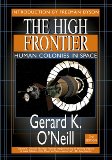A book ahead of its time, The High Frontier – Human Colonies in Space was written by Gerard K. O’Neill (1927-1992) and first published in 1976. O’Neill was an American physicist and space pioneer. He was born in Brooklyn, graduated from Swarthmore College in 1950, and received a doctorate in physics from Cornell University in 1954. He joined the faculty of Princeton University, which he remained associated with until his death. As a faculty member of Princeton University, he invented the particle storage ring and the O’Neill cylinder. He began his studies on the colonization of space in 1969.
Â
The book contains a possible roadmap for the human settlement of the Solar System, essays by experts in the field of space research (David P. Gump, Peter E. Glaser, Margo R. Deckard, George Friedman, Rick N. Tumlinson, John S. Lewis), and a CD-ROM featuring presentations by Gerard O’Neill and the Space Studies Institute.
Â
Gerard K. O’Neill presents three major designs for human space colonies. He calls these designs Island One, Island Two, and Island Three. Just to have an idea of the scale of these artificial structures, Island Three consists of two counter-rotating cylinders (also known as the O’Neill cylinders) each two miles in radius, and capable of scaling up to twenty miles long. Each cylinder has six stripes that run the length of the cylinder. Three stripes are transparent (the “windows”), allowing the sunlight inside and three stripes correspond to the land. Each one of these designs represents a stage in the colonization of the space close to Earth. The two major resources needed for developments of such scale are energy and building materials. The proposed solutions are Satellite Solar Power Stations and mining operations on the Moon. Earth cannot be used as a source of raw materials needed for the construction of the colonies due to the prohibitive launching costs. Mass drivers powered by solar power or nuclear reactors on the surface of the Moon would be able to provide raw materials at prices at least one order of magnitude lower than the traditional payload carriers used in the present.
Â
Gerard K. O’Neill presented his vision on space colonization and he described the driving force behind it as an economic force. Considering the latest developments in Space Tourism and the growing interest that venture capitalists show, the roadmap that Gerard K. O’Neill described seems to be less of a dream and more of a reality.
Â










 Subscribe to our RSS feed
Subscribe to our RSS feed











There are no comments.
Add A Comment